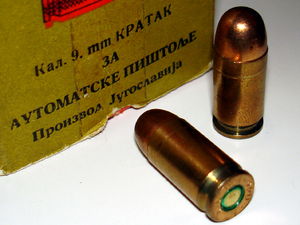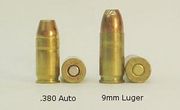.380 ACP
| .380 ACP | ||
|---|---|---|
 Yugoslavian "9 mm Kratak" (9 mm Short) cartridges, FMJ. |
||
| Type | Pistol | |
| Place of origin | ||
| Production history | ||
| Designer | John Browning | |
| Manufacturer | Colt's Manufacturing Company | |
| Produced | 1908 | |
| Specifications | ||
| Case type | Rimless, straight | |
| Bullet diameter | .355 in (9.0 mm) | |
| Neck diameter | .373 in (9.5 mm) | |
| Base diameter | .374 in (9.5 mm) | |
| Rim diameter | .374 in (9.5 mm) | |
| Rim thickness | .045 in (1.1 mm) | |
| Case length | .680 in (17.3 mm) | |
| Overall length | .984 in (25.0 mm) | |
| Ballistic performance | ||
| Bullet weight/type | Velocity | Energy |
| 90 gr (5.8 g) JHP | 1,000 ft/s (300 m/s) | 200 ft·lbf (270 J) |
| 95 gr (6.2 g) FMJ | 980 ft/s (300 m/s) | 203 ft·lbf (275 J) |
| Test barrel length: 3.75 Source: Federal Cartridge [1] |
||
The .380 ACP (Automatic Colt Pistol) pistol cartridge is a rimless, straight-walled pistol cartridge developed by firearms designer John Browning. The cartridge headspaces on the mouth of the case.[2] It was introduced in 1908 by Colt, and has been a popular self-defense cartridge ever since. Other names for .380 ACP include .380 Auto, .380 Short, 9mm Browning, 9mm Corto, 9mm Kurz, 9mm Short, and 9x17mm. It is not to be confused with .38 ACP.
Contents |
Design
The .380 ACP cartridge was designed for early blowback pistols which lacked a barrel locking mechanism. The locking mechanism that is found on most other pistols is not necessary for the .380 because of the round's low breech pressure or bolt thrust when fired. The recoil spring and the mass of the slide itself are enough to buffer the recoil energy of the round. This simplifies manufacture of pistols chambered for such a round, generally thereby lowering the cost. It also permits the barrel to be permanently fixed to the frame, which promotes accuracy. There have, however, been a number of locked-breech pistols chambered in .380 ACP. There have also been some diminutive submachine guns, such as the Ingram MAC-11[3] and vz. 83.[4]
Uses
The 380 acp has experienced alot of use over the years it was famously used by many german officers during WW2 in the walther ppk aswell as Italians with the M1934 Beretta as a service pistol but do to its low power it did not go much further in law enforcement or military service as a main gun. It found use as a backup gun due to the fact its combat proven, it also has found uses in the civilian market as a personal defense round.Currently the 380acp/9mmkurz is one of the most popular of all time in concealed carry guns and in recent years with looser concealed carry laws in many States the small 380 acp caliber is comeing back in many compact, sub compact, & micro compact firearms. Due to its reletively small size its very easy to design many guns around the 380acp, this round could easily enjoy another 100+ years before becoming obselete.
Performance
The .380 ACP is compact and light, but has a relatively short range and less stopping power than other modern pistol cartridges.[5] Even so, it remains a popular self-defense cartridge for shooters who want a lightweight pistol with manageable recoil. It is slightly less powerful than a standard-pressure .38 Special and uses 9 mm (.355 in) diameter bullets. The heaviest bullet that can be safely loaded into the .380 ACP is 115 grains (7.5 g), though the standard has long been 85, 90 or 95 grains (5.5, 5.8 or 6.2 g). The .380 has had something of a recent upsurge in popularity with the increase of concealed carry laws, as have the compact and inexpensive pistols that make use of it. Popular pistols chambered in .380 ACP include the Walther PPK/S, Bersa Thunder 380, Kel-Tec P-3AT and Ruger LCP. Glock also produces models in .380, though they are not available to the U.S. market because they do not earn enough "points" for importation under Federal law.
The wounding potential of bullets is often characterized in terms of a bullet's expanded diameter, penetration depth, and energy. Bullet energy for .380 ACP loads varies from roughly 190 to 220 ft•lbf. It has been shown that bullets transferring over 500 ft•lbf of energy in 12 inches of penetration can produce remote wounding effects sometimes called hydrostatic shock. At .380 ACP levels of energy, these remote wounding effects and enhanced incapacitation do not occur. Consequently, bullet performance depends on directly crushing tissue by means of expansion and penetration. The table below shows common performance parameters for several .380 ACP loads. Bullet weights from 85 to 95 grains are common. Penetration depths from 6.5 inches to 17 inches are available for various applications and risk assessments. The Marshall and Sanow "one-shot stop" rating varies from 51% for the non-expanding FMJ to roughly 70% for the some JHPs. The average incapacitation times (estimated for a 170 lb male shot in the center of the chest) vary from 9.3 to 14.9 seconds.
| Manufacturer | Load | Mass (grains) | Velocity (ft/s) | Energy (ft•lbf) | Expansion (inches)[6] | Penetration (inches)[6] | BPW[7](psi) | PC[6] (in3) | TSC[6] (in3) | OSS[6] | AIT[7] (sec) |
|---|---|---|---|---|---|---|---|---|---|---|---|
| Cor-Bon | JHP +P | 90 | 1050 | 220 | 0.58 | 9.0 | 467 | 2.38 | 15.7 | 70.0% | 10.2 |
| Federal | HydraShok JHP | 90 | 1000 | 200 | 0.58 | 10.5 | 365 | 2.77 | 21.0 | 69.0% | 11.5 |
| Winchester | Silvertip JHP | 85 | 1000 | 189 | 0.63 | 6.5 | 555 | 2.03 | 10.6 | 61.0% | 9.3 |
| CCI/Speer | JHP | 88 | 1000 | 196 | 0.36 | 17.0 | 654 | 1.73 | 9.1 | 57.6% | 14.8 |
| Hornady | XTP | 90 | 1000 | 200 | 0.44 | 11.8 | 324 | 1.73 | 9.1 | 53.9% | 12.2 |
| Federal | FMJ | 95 | 955 | 193 | 0.36 | 17 | 217 | 1.73 | 8.7 | 51.4% | 14.9 |
Key: Expansion – expanded bullet diameter (ballistic gelatin). Penetration – penetration depth (ballistic gelatin). BPW – ballistic pressure wave associated with remote wounding effects known as hydrostatic shock. PC – permanent cavity volume (ballistic gelatin, FBI method). TSC – temporary stretch cavity volume (ballistic gelatin). OSS – Marshall and Sanow “one-shot stop” rating. AIT – Average incapacitation time, time from unobstructed hit in the center of the chest until involuntary incapacitation for 170 lb male as determined from ballistic pressure wave model.
Synonyms
- .380 Auto
- 9mm Browning
- 9mm Browning Short
- 9mm Corto
- 9mm Court
- 9mm Kratak
- 9mm Kurz
- 9mm Scurt
- 9mm Short
- 9x17mm

See also
- 9 mm caliber
- List of firearms
- List of handgun cartridges
References
- ↑ "Federal Cartridge Ballistics". http://www.federalcartridge.com/ballistics/. Retrieved 2007-09-25.
- ↑ Wilson, R. K. Textbook of Automatic Pistols, p.241. Plantersville, SC: Small Arms Technical Publishing Company, 1943.
- ↑ "Ingram MAC Model 10 / M10 and Model 11 / M11 submachine guns (USA)". http://world.guns.ru/smg/smg22-e.htm. Retrieved 2007-09-25.
- ↑ Jones, Richard (2009). Jane's Infantry Weapons 2009-2010. Jane's Information Group. p. 107. ISBN 0710628692.
- ↑ ".380ACP Terminal Ballistics". http://www.stevespages.com/page8f380acp.html. Retrieved 2007-09-25.
- ↑ 6.0 6.1 6.2 6.3 6.4 Marshall and Sanow, Street Stoppers, Appendix A, Paladin 2006
- ↑ 7.0 7.1 From model in Courtney A, Courtney M: Links between traumatic brain injury and ballistic pressure waves originating in the thoracic cavity and extremities. Brain Injury 21(7): 657–662, 2007.
External links
- Colt Automatic Pistols Home Page
- Article on Defensive Use of .380 ACP from American Rifleman
- StoppingPower.Info .380 ACP vs various target videos
|
|||||||||||||||||||
|
||||||||||||||
